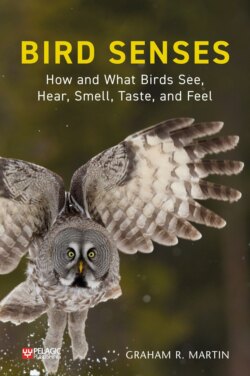Читать книгу Bird Senses - Graham R. Martin - Страница 31
На сайте Литреса книга снята с продажи.
Training and testing
ОглавлениеThis type of simple discrimination is likely to be learned robustly by most birds. Once trained, birds will make the correct choice at least 90% of the times that a pair of stimulus panels is presented. In many cases mistakes are never made, the birds being consistently 100% correct. By ensuring that the birds gain most of their daily food intake in these sessions, and that the sessions take place at the same time every day, the birds will be highly motivated to respond when they come to a training session. Also, it is best to give a bird a training or testing session every day, no time off at weekends.
Depending on the species and on the individual birds, this initial training may be completed in a couple of weeks, but it can take a couple of months. The investigator has to be alert to the possibility that the birds will learn to solve the problem posed by using a cue other than the one that the investigator intends. When birds are being trained to make these kinds of visual discriminations they can be particularly alert to sound cues which might also reliably indicate where to go to get food. So, for example, a click or rumble associated with changing the positions of the panels between left and right could well be learned, and the bird may then ignore the orientation of the stripes. This is perhaps not too surprising. After all, from the bird’s point of view the task is to learn how to get its food reliably, and any cue that is consistent is as good as another, and sounds are very important to birds. So if the investigator introduces more than one reliable cue the bird could latch on to any of those that are available.
Once this initial training has settled down and the investigator can be sure that the bird is responding only to stripes of the correct orientation, the actual investigation of sensory abilities can begin. The first stage is to start presenting the birds with pairs of stripes of the same width but to change stripe width between trials. On some trials stripes will be very wide and the difference between the panels’ orientations will be obvious to the bird. However, if the stripes of the grating pattern are made very narrow the task will be difficult, as the fine stripe pattern cannot be determined and the panel looks a uniform grey.
The result is that on some trials the birds may make a mistake, and errors will start to systematically creep in. If the stripes are so narrow that they are below the birds’ threshold and they truly cannot ever tell the panels apart, then random behaviour would be expected, and the birds would get the task correct on only 50% of the trials. At intermediate stripe widths, however, the birds may get the discrimination correct on 70% or 80% of the trials. Over time, by mixing up trials with different stripe widths, a bird’s motivation to keep responding even on difficult trials can be maintained.
